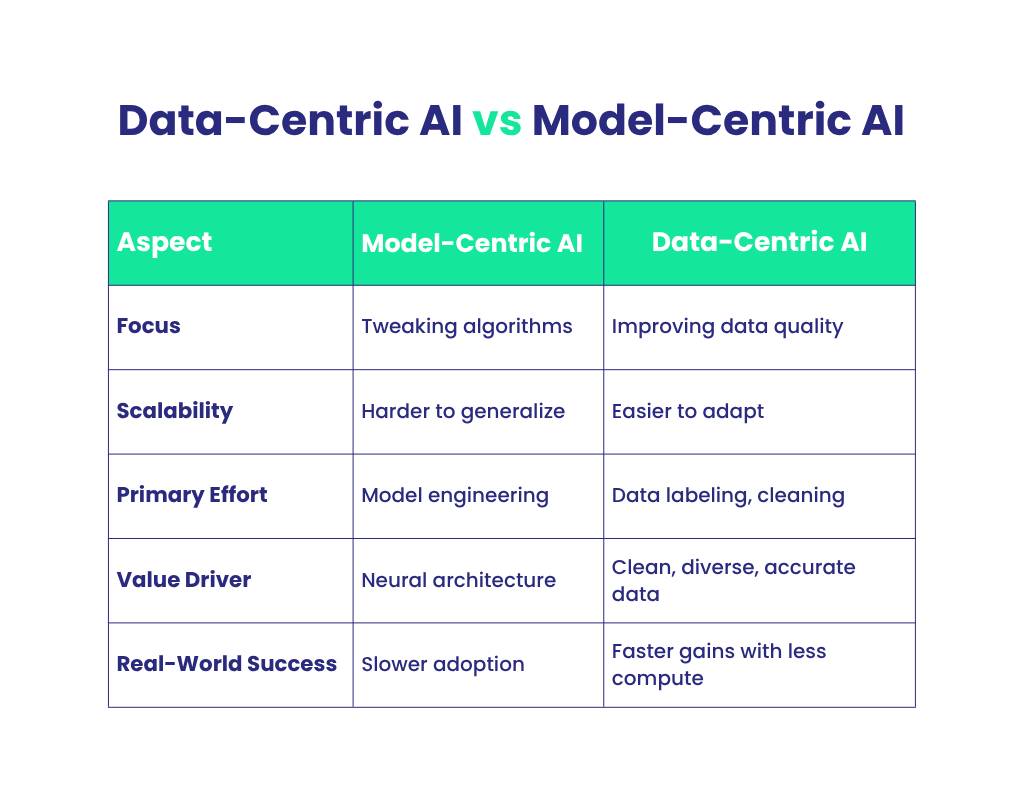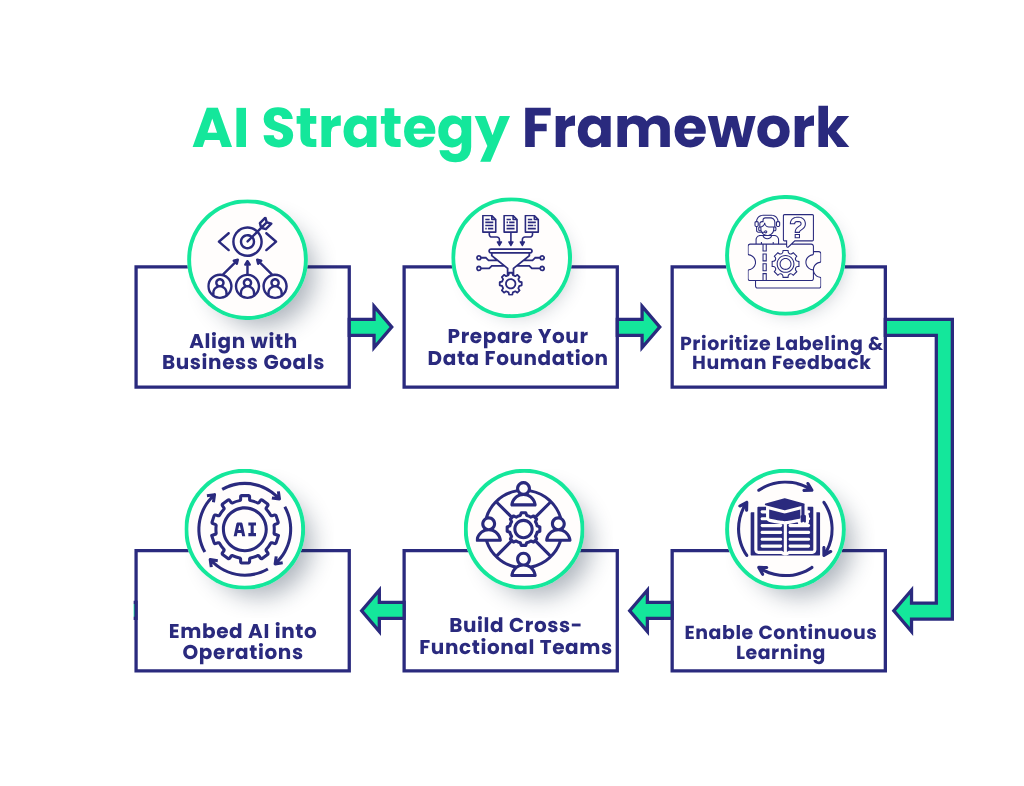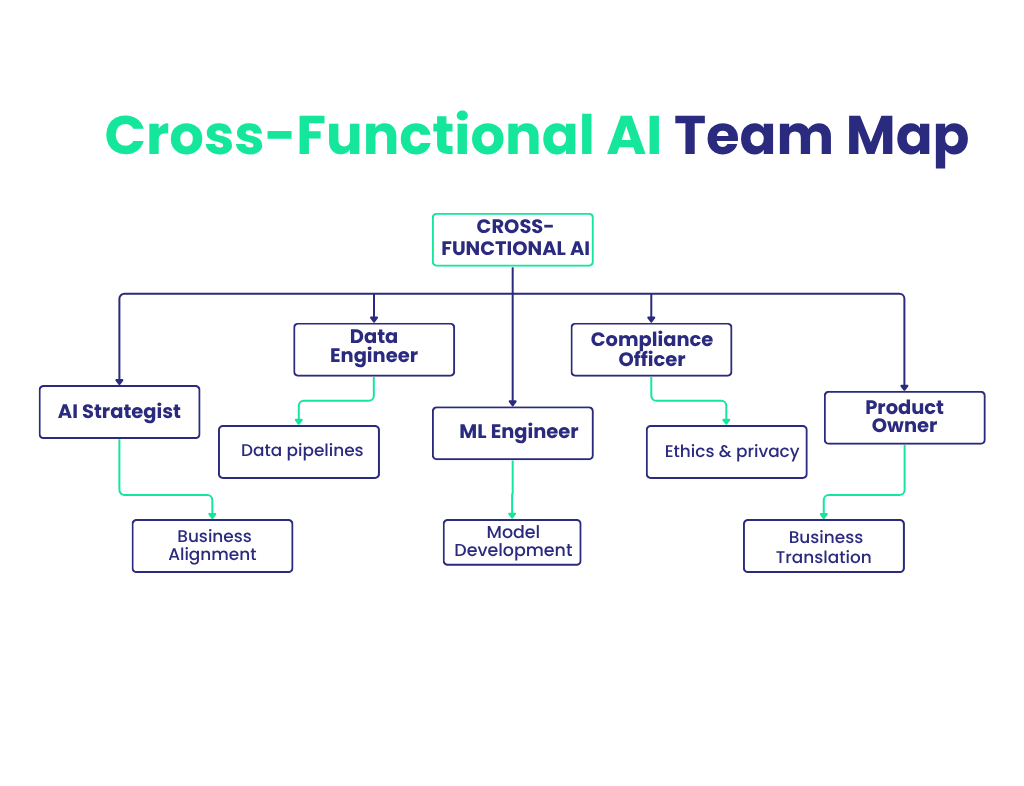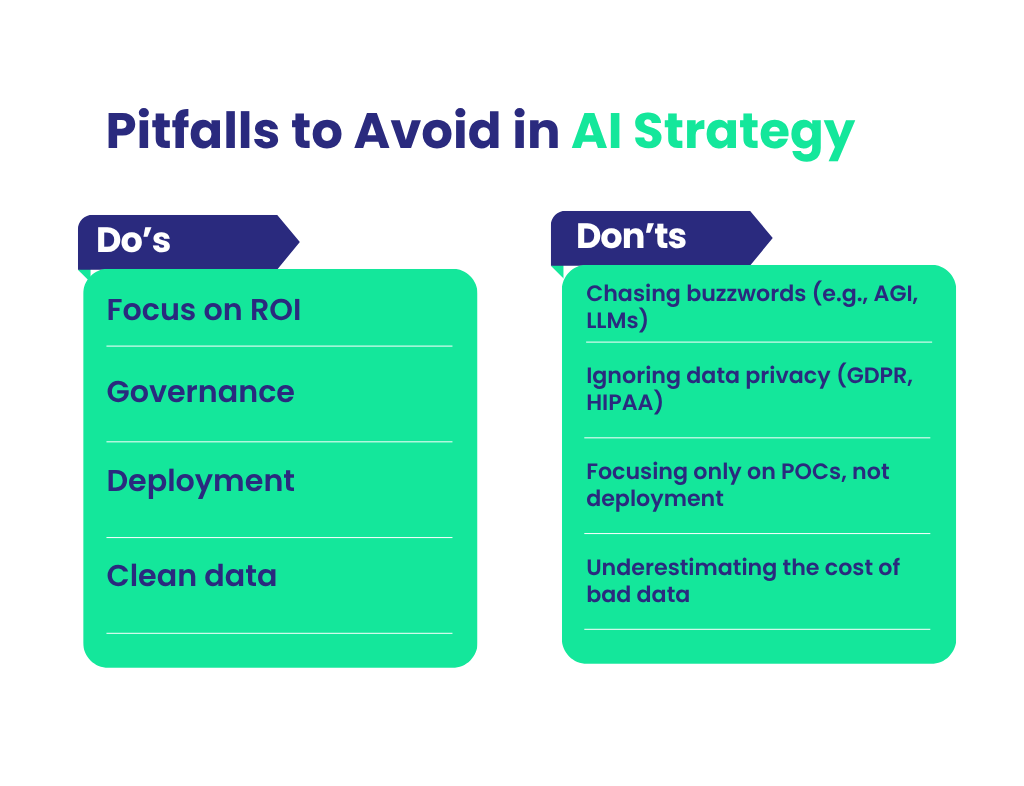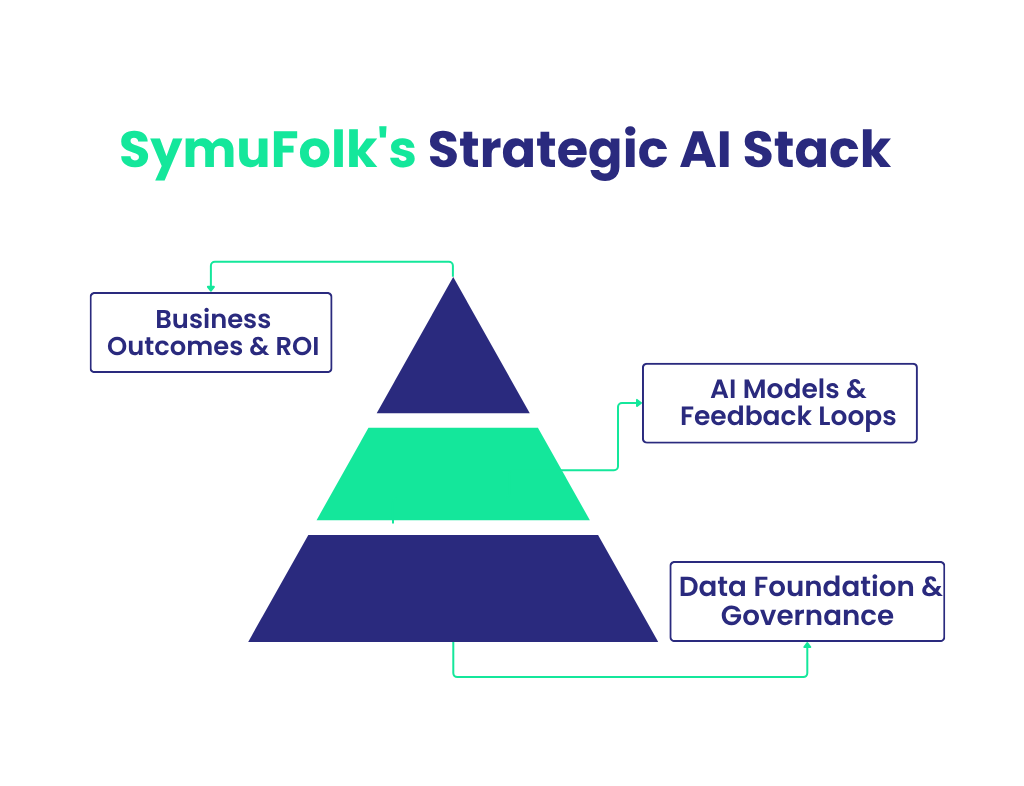In today’s hyper-competitive landscape, every organization is under pressure to harness the power of artificial intelligence. But the success of AI doesn’t just depend on model selection or compute power – it hinges on how well your data and AI strategy aligns with your business goals.
A data-centric AI strategy places data – not algorithms – at the heart of your AI implementation. This approach is proving to be the most sustainable path toward building reliable, scalable, and explainable AI systems.
Whether you’re a startup or an enterprise looking to modernize, this guide will walk you through the best practices and common pitfalls of crafting an effective AI data strategy that supports long-term business growth.
These applications demonstrate how a data-centric approach can unlock custom AI business solutions tailored to specific industry needs.
Why a Data-Centric Approach is the Future of AI
The value of AI doesn’t lie in algorithms alone. The true differentiator lies in the quality, diversity, and structure of your data. A data and AI strategy that emphasizes data cleanliness, relevance, and coverage leads to AI systems that are not only more accurate but also more trustworthy and scalable.
Traditional AI strategies often emphasize model engineering. However, in many real-world cases, simply improving the data used to train those models can result in significantly better performance. This realization has given rise to the data-centric AI movement, championed by leaders like Andrew Ng and widely adopted by forward-thinking enterprises.
In this approach, data becomes the primary lever for model improvement. Instead of tweaking hyperparameters or adding layers to neural networks, organizations focus on:
- Improving data labeling accuracy
- Removing noisy or biased examples
- Ensuring balanced representation of all relevant classes
- Regularly updating data to reflect current realities
These enhancements can unlock gains that far surpass those achieved by upgrading the model alone.
1. Align AI with Strategic Business Objectives
The first pillar of a successful AI data strategy is aligning it with core business objectives. Too often, AI projects fail because they are pursued without a clear understanding of the problem they are meant to solve.
Questions to consider:
- What business problem are we trying to solve?
- What metrics define success?
- How can AI integrate with existing workflows?
By answering these questions, you can ensure that your AI initiatives are both relevant and outcome-driven. For example, a financial services company might use AI for fraud detection, while a retail chain could leverage it to optimize inventory.
A seasoned AI strategist works hand-in-hand with stakeholders to connect technical initiatives with business outcomes, ensuring your AI implementation drives measurable impact. This strategic alignment ensures that the AI doesn’t operate in isolation but enhances your core operations and services.
2. Invest in Data Readiness Before AI Readiness
Data is the lifeblood of AI. If it’s fragmented, outdated, or unstructured, your models will struggle. Companies must assess their current data infrastructure to ensure it supports large-scale, intelligent systems.
Steps to assess your data readiness:
- Perform a comprehensive data audit to identify gaps, redundancies, and inconsistencies.
- Break down data silos by unifying disparate systems through APIs and data lakes.
- Apply data governance frameworks that define data ownership, access controls, and quality benchmarks.
In regulated industries like healthcare or finance, strong data governance also ensures compliance with regulations such as GDPR, HIPAA, and CCPA. Without these protections in place, your AI project could expose your business to significant legal and reputational risks.
3. Prioritize Label Quality and Human Feedback
AI models are only as good as the data they’re trained on—and the labels that guide them. In a data-centric AI strategy, labeling is no longer treated as a secondary task but as a mission-critical investment.
Best practices:
- Use human-in-the-loop systems where domain experts verify or correct machine-generated labels.
- Implement active learning, where the model identifies uncertain predictions and requests human input.
- Periodically review and update labels to reflect shifts in customer behavior, regulatory changes, or new use cases.
When businesses think deeply about how data thought processes are structured and evolve, they reduce bias and improve reliability. Human feedback not only improves model accuracy but also builds trust in AI systems.
4. Embed AI in Strategic Planning and Operations
A mature AI business model doesn’t treat AI as a feature, but as an integrated part of strategic planning. This means embedding AI into day-to-day decision-making:
- Demand forecasting to better manage supply chain fluctuations.
- Churn prediction to retain high-value customers.
- Dynamic pricing based on competitor activity and consumer sentiment.
By leveraging AI for real-time insights, organizations can become more agile, reduce waste, and improve ROI across departments. This is where AI for strategic planning becomes transformative.
For Example:
A digital health network uses AI to forecast emergency room admissions by analyzing historical admission rates, disease outbreaks, air quality indexes, and even real-time local event data. The predictive model helps hospitals anticipate patient loads, allocate nursing staff, and prioritize ICU beds efficiently.
5. Build Cross-Functional Teams for AI Success
AI implementation isn’t just a technology problem—it’s an organizational one. Silos between technical and business teams often derail even the most well-funded initiatives.
Roles involved:
- Data Engineers: Build and maintain data pipelines.
- Data Scientists & ML Engineers: Develop models and tune them for performance.
- Product Owners: Translate business needs into technical requirements.
- Compliance Officers: Ensure adherence to legal and ethical guidelines.
Cross-functional collaboration encourages shared accountability, better communication, and faster time to value. Building these bridges is key to deploying custom AI business solutions that reflect the unique needs of your company and customers.
6. Design for Iteration and Continuous Learning
Data doesn’t stand still—and neither should your AI. The most successful AI systems are those built with continuous improvement in mind.
Build feedback loops for:
- Model drift detection: Ensure predictions remain relevant over time.
- User feedback integration: Capture corrections or preferences from end-users.
- Automated retraining: Schedule model updates based on new data availability.
This agility ensures that your AI implementation remains accurate and aligned with business needs. It also enables your models to evolve with market dynamics, regulatory shifts, or customer behavior.
Pitfalls to Avoid in Your Data & AI Strategy
Chasing Hype Over Practicality
Too many organizations get caught up in buzzwords like “deep learning” or “AGI” without understanding the specific value AI can bring to their operations. Avoid generic use cases and focus on those that are mission-critical.
Ignoring Privacy and Governance
A solid AI strategy must include rigorous attention to data privacy and ethics. Misuse of data, intentional or accidental, can result in massive fines and public backlash. Incorporate privacy by design from the outset.
Overlooking Deployment and Maintenance
Many AI models fail to make it past the proof-of-concept stage because deployment and maintenance were an afterthought. Think beyond training—consider the full lifecycle of your AI application, from integration to ongoing support.
Underestimating Costs of Poor Data
Relying on outdated or incomplete data can lead to misleading predictions and poor business decisions. The cost of bad data is often invisible until it impacts your bottom line. Prioritize data quality from day one.
The Role of AI Strategists in Modern Business
An AI strategist is more than a tech consultant—they are the architect of your digital future. They bridge the gap between business and technology, guiding you through:
- Data infrastructure planning
- Use case identification
- Vendor evaluation
- Team resourcing
With a seasoned strategist, your organization is better equipped to develop a sustainable AI business model that evolves with your needs. They play a pivotal role in ensuring your investment in AI aligns with both immediate goals and long-term vision.
Symufolk’s Role in Strategic AI Development
At Symufolk, we help companies across Europe and North America move beyond pilot projects. Our team of AI strategists, data engineers, and product developers work collaboratively to:
- Build scalable AI business development pipelines
- Design and deploy custom AI business solutions
- Ensure long-term ROI with a data-centric foundation
Whether you’re exploring AI for the first time or scaling an enterprise-grade solution, our approach ensures your data is more than an asset—it’s your competitive edge.
A data-centric AI strategy isn’t just a technical play—it’s a business imperative. Organizations that align their artificial intelligence business strategies and applications with robust, responsible data practices will lead in the next era of digital transformation.
Want to unlock the real value of your data? Get in touch with SymuFolk to explore strategic AI development tailored to your needs.







